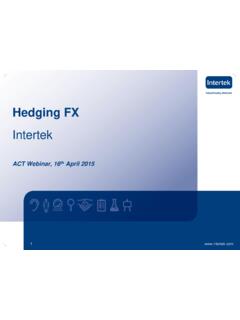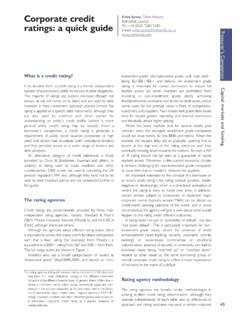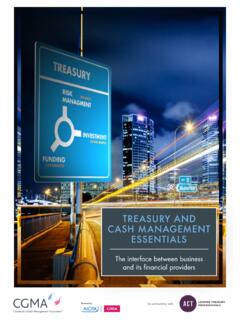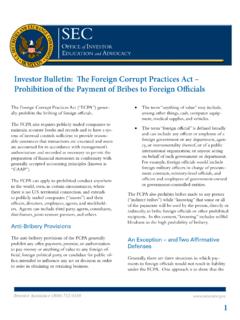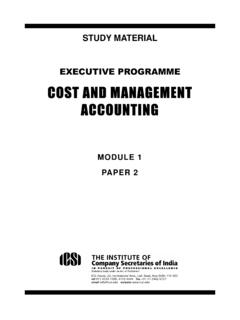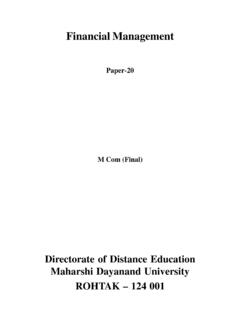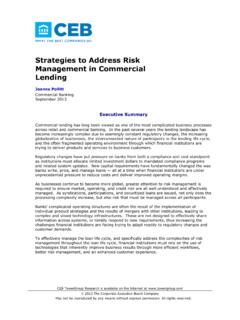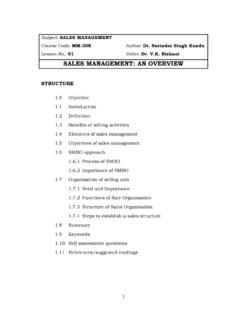Transcription of INTER-COMPANY FUNDING Seeking a perfect structure
1 14 THE TREASURERCASH management SUPPLEMENT ISPRING 2009cash managementINTER- company FUNDINGMost businesses are formed of groups ofcompanies which comprise a parent and itssubsidiaries, and much of treasury managementis about financing the overall group or theparent. But beneath the glamour of group FUNDING lies theissue of FUNDING its subsidiaries. Many of the same issues,such as the split between debt and equity and the length andterms of borrowing, arise for subsidiaries as they do for thegroup or parent. In this article we will refer to:nparent (the holding company for the group);nsubsidiary (any group company , whatever the level ofownership); andngroup (the parent and all subsidiaries, as defined above). INTER-COMPANY FUNDING is important to shareholder value. Theoverriding aim of any business is to increase value forshareholders that is, the parent s shareholders.
2 Individualsubsidiaries have to add value, not only for themselves butalso for the parent, and efficient FUNDING of subsidiaries isimportant to maximise the value of the parent s stake inthem. Efficient FUNDING of subsidiaries also enables the groupto deploy cash efficiently, wherever needed in the group. Thismight be to pay dividends to shareholders, to pay interest oncentral borrowings, or to invest in new shareholder value is measured through cashflows,the treasurer s first concern will be for the management ofcash. The trend towards centralisation of management andcontrol means that a treasurer who can control the cash inany country is 90% of the way to an ideal structure . In groups with many overseas subsidiaries or joint ventures,the management of their FUNDING takes up large amounts oftime and the department forms very strong bonds with thetax department. KEY ISSUES A number of key considerations play a majorpart in any INTER-COMPANY FUNDING decision.
3 These areimportant for all subsidiaries, but particularly for anysubsidiaries located overseas where many of the issues areencountered all the on whether a subsidiary should bewholly or partly owned is a critical decision. Equity ownershipof 100% gives the parent total control, but also leaves it with100% of the equity risk in the subsidiary. Ownership of 100%also implies moral and legal obligations by the parent tomanage the subsidiary properly. If the parent holds less than100% (and in some circumstances this need only be a fewper cent less), the parent will generally have to negotiatewith the other shareholders each time it wants to takeaction. Two sets of investors may have very differentobjectives, and minority shareholders may be unwilling tobear their fair share of their obligations to the subsidiary. Inmany countries, either a local shareholder is required by lawor is a political necessity.
4 NEquity versus debtThe next key decision is the amount ofequity and debt. In an ideal world shareholders will wish tominimise their stake, and hence their risk, leaving thesubsidiary with little equity and substantial local reasons for minimising the level of equity include:nminimising the level of equity and maximising the debtSeeking a perfectstructureINTER- company FUNDING AND ALTERNATIVE FUNDING summary This article looks at the key decisions in managing INTER-COMPANY FUNDING and its importance for shareholder value. CASH management SUPPLEMENT ISPRING 2009 THE TREASURER 15cash managementINTER- company FUNDING generates the maximum return on equity; ninterest is tax-deductible whereas dividends are not, somaximising interest expense gains the maximum taxdeduction for the interest so long as there are taxableprofits; and nminimising the level of equity minimises the chance oftrapped funds (funds that cannot be remitted as dividendsdue to a lack of distributable profits) in the group real-world factor that increases the amount of equity ingroup companies is gearing.
5 Lenders will only be willing tolend up to a certain point. The balance of FUNDING has then tobe sourced from equity and the subsidiary may not be able toafford the interest. Another factor is tax. Tax authorities commonly have thincapitalisation rules that impose a minimum proportion ofequity and maximum debt level for companies. Any interestpaid on borrowings in excess of the limit is treated asdividends, and so is not SUPPORT So long as the parent has a legal ormoral obligation to prevent the subsidiary from defaulting,the group actually has no independentcapital the proportion of debt and equity still matters fortax purposes, for risk purposes the credit strength of thesubsidiary is that of the overall group. When parent companyguarantees are given to subsidiaries creditors, the benefitsgained by using high local debt levels tend to companies have a policy of never giving parentcompany guarantees, although on occasion it is impossible toavoid doing so.
6 However, it can be argued that the parentthat walks away from its insolvent subsidiary is likely to haveproblems with all lenders thereafter. Parent companies may prefer to issue letters of comfort,which evidence the moral obligation to support thesubsidiary, without accepting a legal obligation to do so. If a creditor is able to seek support from the parent, this isknown as recourse to the parent. SOURCE OF DEBT FUNDING Debt FUNDING for the groupwill always ultimately be sourced externally. However, agroup structure allows for a subsidiary s borrowings to beeither locally or centrally from the parent (and channelled tothe subsidiary by INTER-COMPANY loan). Local external borrowing may be useful to underpin localbanking services such as cash management , trade finance orforeign exchange facilities. However, it can be moreexpensive than INTER-COMPANY lending. Interest on cross-border borrowing (for example, an INTER-COMPANY loan) mayattract withholding tax (levied by the remitting country s taxauthorities on the income to the recipient).
7 CASH management SYSTEMS The importance of cashmanagement systems relates to the importance of cash as agroup resource. Not only do subsidiaries need to be funded,but as they generate cash the parent needs the ability toTable 1:The ideal FUNDING structureStructureCommentSubsidiary is owned 100%Treasurer can dictate FUNDING methods and policySubsidiary has a very low equity baseReduces the amount of capital at risk in the country and implies high debtSubsidiary has a high level of debtInterest on debt is tax-deductible and decreases profits,reducing the tax issues of trapped cash (where cash movements to parent are forbidden)Trade creditors rely on parental name for security Parental support is rarely legally binding. No issues on lack of trade creditCompany has low-cost external debt which is non-recourse to the parent Local debt is likely not to attract withholding tax on interest and reduces capitalat risk in the country because the subsidiary can be allowed to failIf cheaper finance can be obtained by adding theparent s or group s support by way of guarantee orcomfort letter, this is added if it saves costsThe benefit of lower cost debt is balanced against higher group capital at riskIf cheaper finance can be achieved by lending INTER-COMPANY , this is added if it saves costsParental loans are likely to be the cheapest form of debt.
8 If the subsidiary scountry is secure from risk, INTER-COMPANY FUNDING is often bestInter- company FUNDING can be made and repaid at willMinimum cash balances are held locally Currency is convertibleCash remittances easily converted to or from other currencies used by the groupCash management system in country allows same-daycash movements, remote access by parent and poolingNo delay in FUNDING cash needs or collecting surplus cash,no need to rely onlocal management , and efficient management of local cash and liquidityDividends freely remittable and suffer no withholding taxTiming of dividends can be made to suit tax planning in the parentManagement charges/royalties permitted and tax-deductibleFurther flexibility for tax planning,and further reduction in local taxable profitcash managementINTER- company FUNDING16 THE TREASURERCASH management SUPPLEMENT ISPRING 2009defundthem in order to safeguard the cash centrally and useit elsewhere as needed.
9 Cash management systems areimportant to ensure that cash can be moved efficiently andquickly around the group. REMITTANCE TO AND FROM THE PARENT The parent mayneed to send cash to subsidiaries or extract it from are five core forms of remittance, and all non-tradingflows (flows that are not settling INTER-COMPANY tradingtransactions) must take one of these forms. nEquity injectionA permanent means of sending cash fromthe parent to the subsidiary by buying shares. nLoanA means of temporarily sending funds in eitherdirection between parent and subsidiary. Loans must bedocumented and interest-bearing at market rates in orderto comply with international transfer pricing rules. nDividendsA means of sending cash permanently fromsubsidiary to parent. Dividends can only be paid out ofdistributable profits. nRoyaltiesAnother means of sending cash permanentlyfrom subsidiary to parent.
10 Royalties must be paid inaccordance with a royalty agreement and at market are paid from pre-tax profit and are generallydeductible for tax purposes. nFees and chargesAnother means of sending cashpermanently from subsidiary to parent. Fees and chargesmust be paid in accordance with a management agreementfor services actually provided by the charging entity (suchas central accounting or treasury services). Fees andcharges are paid from pre-tax profits and are generallydeductible for tax purposes. THE IDEAL FUNDING structure The ideal overseassubsidiary would have the features outlined in Table TO FUNDING STRUCTURES In the realworld there are limitations on what can be achieved. Table 2shows the effect of having to cope with a less than is no single ultimate answer to the perfect subsidiaryfunding structure . It can be seen that each country andsubsidiary has to be managed on an individual basis.

